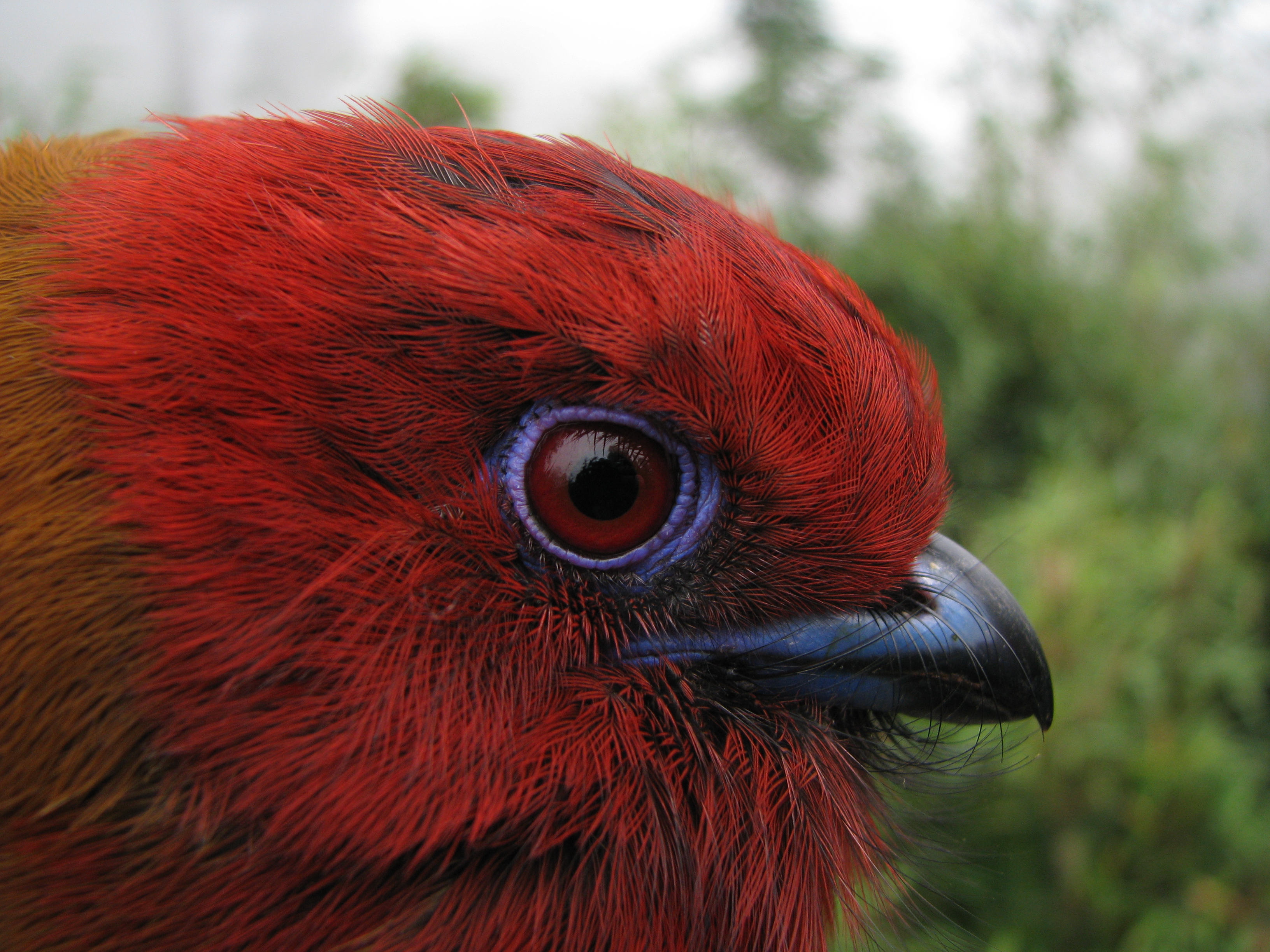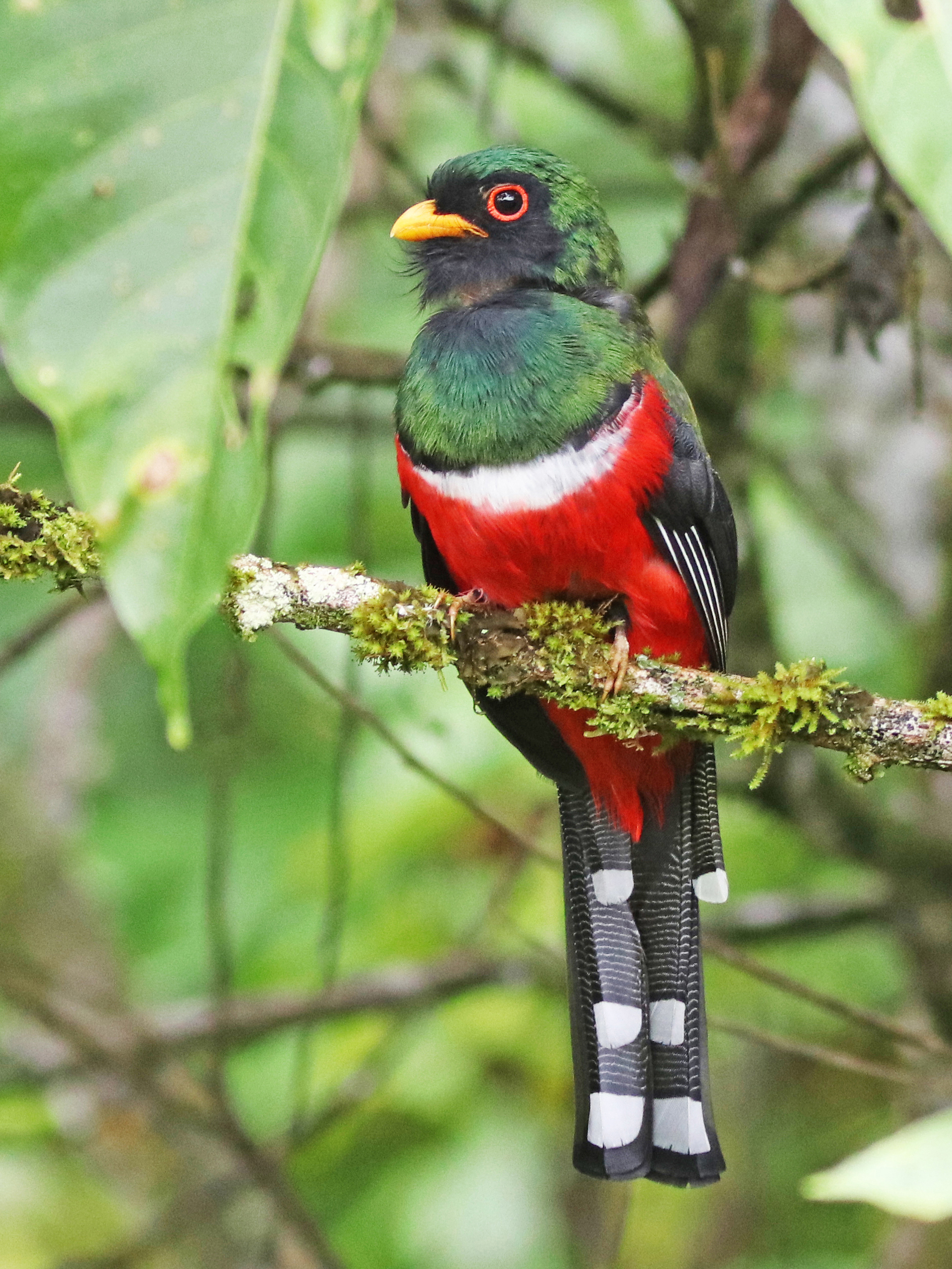|
Trogons
The trogons and quetzals are birds in the order Trogoniformes which contains only one family, the Trogonidae. The family Trogonidae contains 49 species in seven genera. The fossil record of the trogons dates back 49 million years to the Early Eocene. They might constitute a member of the basal radiation of the order Coraciiformes and order Passeriformes or be closely related to mousebirds and owls. The word ''trogon'' is Greek for "nibbling" and refers to the fact that these birds gnaw holes in trees to make their nests. Trogons are residents of tropical forests worldwide. The greatest diversity is in the Neotropics, where four genera, containing 34 species, occur. The genus '' Apaloderma'' contains the three African species. The genera '' Harpactes'' and ''Apalharpactes'', containing twelve species, are found in southeast Asia. They feed on insects and fruit, and their broad bills and weak legs reflect their diet and arboreal habits. Although their flight is fast, they are r ... [...More Info...] [...Related Items...] OR: [Wikipedia] [Google] [Baidu] |
Euptilotis
The eared quetzal (''Euptilotis neoxenus''), also known as the eared trogon, is a near passerine bird in the trogon family, Trogonidae. It is native to streamside pine-oak forests and canyons in the Sierra Madre Occidental of Mexico from northern Sonora and Chihuahua south to western Michoacán. The species has occurred on rare occasions in southeastern Arizona, where it has been recorded nesting. Taxonomy The eared quetzal was described and illustrated in 1838 by the English ornithologist and bird artist John Gould in his book ''A Monograph of the Trogonidae, or Family of Trogons'' based on a specimen collected in Mexico. He coined the binomial name ''Trogon neoxenus''. In 1858, in the second edition of his book, Gould placed the species in its own genus ''Euptilotis'' to give the current binomial name ''Euptilotis neoxenus''. The eared quetzal is the only species placed in the genus. The specific epithet combines the Ancient Greek meaning "new" with meaning "stranger", " ... [...More Info...] [...Related Items...] OR: [Wikipedia] [Google] [Baidu] |
Red-headed Trogon
The red-headed trogon (''Harpactes erythrocephalus'') is a species of bird in the family Trogonidae. Etymology ''H. erythrocephalus'' comes from the Ancient Greek terms ἐρυθρός ''eruthros'' meaning red and κεφαλή, ''kephalē'' meaning head. Description The red-headed trogon is on average in length. The male has a red head and breast, a unique feature in the Trogon group. The female resembles the Diard's trogon without a speckled undertail. The head, neck and upper breast of an adult male is dull crimson. A narrow white band crosses the mid breast, underneath which the lower breast to abdomen is light red to pink. Pale red can be observed on the flanks whereas the wikt:mantle, mantle and back of the bird are rusty brown. The male perches on branches with the support of mauve-blue legs. Regarding wing colouration, the lesser and median wing coverts, secondary coverts, as well as outer webs of tertials and Flight feather#Secondaries, secondaries are vermiculated b ... [...More Info...] [...Related Items...] OR: [Wikipedia] [Google] [Baidu] |
Red-naped Trogon
The red-naped trogon (''Harpactes kasumba'') is a species of bird in the family Trogonidae. It is found in Brunei, Indonesia, Malaysia, and Thailand. Its natural habitat is subtropical or tropical moist lowland forests. It is threatened by habitat loss. Name in different languages * Latin - ''Harpactes kasumba'' * French – Couroucou a masque rouge * German – Rotnacken-Trogon * Spanish – Trogon kasumba * Dutch - Roodnektrogon Life history The red-naped trogon was discovered in 1822 by Sir Stamford Raffles, a military and British naturalist (1781-1826) best known for having founded Singapore in 1817. Morphology and flight The red-naped trogon is a strongly sexually dimorphic species, with the females generally being duller than the males. The male red-naped trogon is physically defined by a black head and upper breast, blue bill and eye ring with a bright blue coloured face. He has yellow-brown upperparts and upper tail with black outlines, a white breast-line, bright ... [...More Info...] [...Related Items...] OR: [Wikipedia] [Google] [Baidu] |
Trogon (genus)
''Trogon'' is a genus of Coraciimorphae birds in the trogon family. Its members occur in forests and woodlands of the Americas, ranging from southeastern Arizona to northern Argentina. They have large eyes, stout hooked bills, short wings, and long, squared-off, strongly graduated tails; black and white tail-feather markings form distinctive patterns on the underside. Males have richly colored metallic plumage, metallic on the upperparts. Although many have brightly coloured bare eye-rings, they lack the colorful patches of bare facial skin in their African counterparts, '' Apaloderma''. Females and young are duller and sometimes hard to identify in the field. Eggs are white or bluish-white, unlike the pale blue eggs of quetzals. See the family account for further details. Taxonomy The genus ''Trogon'' was introduced by the French zoologist Mathurin Jacques Brisson in 1760 with the green-backed trogon (''Trogon viridis'') as the type species. The name of the genus is f ... [...More Info...] [...Related Items...] OR: [Wikipedia] [Google] [Baidu] |
Apalharpactes
''Apalharpactes'' is a genus of birds in the family Trogonidae. They are restricted to humid highland forest on the Indonesian islands of Java and Sumatra. Unlike all other Asian trogons, their plumage is mainly green above and yellow below. Compared to most trogons, the sexual dimorphism is relatively small. The two species in the genus resemble each other, but ''A. reinwardtii'' is larger than ''A. mackloti'', and the male ''A. mackloti'' has a chestnut rump-patch, which ''A. reinwardtii'' lacks. They feed on arthropods, small lizards and fruit. Taxonomy The members of ''Apalharpactes'' are sometimes placed in the genus ''Harpactes'' instead. However a 2010 study found that the two genera are actually distantly related and thus valid. The two species of ''Apalharpactes'' were formerly treated as conspecific under the name red-billed trogon or blue-tailed trogon (''Apalharpactes reinwardtii'', with ''mackloti'' as a subspecies), but are better treated as separate species. Refe ... [...More Info...] [...Related Items...] OR: [Wikipedia] [Google] [Baidu] |
Masked Trogon (Trogon Personatus Temperatus) Male San Isidro
The masked trogon (''Trogon personatus'') is a species of bird in the family Trogonidae. It is fairly common in humid highland forests in South America, mainly the Andes and tepuis. Taxonomy There are eight recognized subspecies of masked trogon: *''T. p. assimilis'' is found in the subtropics of the west Andean slope in Ecuador. *''T. p. duidae'' is found on Mount Duida in the tepui region of southern Venezuela; males of this subspecies are reddish-bronze on the back. *''T. p. personatus'' is found in the subtropical Andes of Venezuela, central and east Andean slopes in Colombia, and east Andean slopes in Ecuador and Peru; males of this subspecies are glossy green above. *''T. p. ptaritepui'' is found in the tepui region of southern Venezuela; males of this subspecies are golden-green on the back. *''T. p. roraimae'' is found on Auyantepui and Monte Roraima, on the border between Venezuela, Guyana and Brazil. *''T. p. sanctamartae'' is found in the Santa Marta Mountains of n ... [...More Info...] [...Related Items...] OR: [Wikipedia] [Google] [Baidu] |
Apaloderma
''Apaloderma'' is a genus of birds in the family Trogonidae. The name is a compound word composed of two Greek words: ''hapalos'', meaning "delicate"and ''derma'', meaning "skin". Established by William Swainson William Swainson Fellow of the Linnean Society, FLS, Fellow of the Royal Society, FRS (8 October 1789 – 6 December 1855), was an English ornithologist, Malacology, malacologist, Conchology, conchologist, entomologist and artist. Life Swains ... in 1833, the genus contains the following species: References Bird genera Birds of Sub-Saharan Africa Taxonomy articles created by Polbot Taxa named by William Swainson {{Trogoniformes-stub ... [...More Info...] [...Related Items...] OR: [Wikipedia] [Google] [Baidu] |
Harpactes
''Harpactes'' is a genus of birds in the family Trogonidae found in forests in South and Southeast Asia, extending into southernmost China. They are strongly sexually dimorphic, with females generally being duller than males. Their back is brownish, the tail is partially white (best visible from below), and males of most species have red underparts. They feed on arthropods, small lizards and fruit. Two species, cinnamon-rumped and scarlet-rumped trogons, were previously classified in a separate genus, ''Duvaucelius'', and a 2010 study found that these two were closely related and formed a separate clade from all of the other ''Harpactes'' trogons (except orange-breasted trogon, which forms a third group), but recommended that all three groups should be treated as congeneric. This same study also found that the genus ''Apalharpactes'', containing two species sometimes included in ''Harpactes'', is actually distantly related and thus a valid genus. Species ... [...More Info...] [...Related Items...] OR: [Wikipedia] [Google] [Baidu] |
Quetzal
Quetzals () are strikingly colored birds in the trogon family. They are found in forests, especially in humid highlands, with the five species from the genus ''Pharomachrus'' being exclusively Neotropical, while a single species, the eared quetzal, ''Euptilotis neoxenus'', is found in Guatemala, sometimes in Mexico and very locally in the southernmost United States. In the highlands of the states of Sonora, Chihuahua, Sinaloa, Durango, Nayarit, Zacatecas, Jalisco, and Michoacán, the eared quetzal can be found from northwest to west-central Mexico. It is a Mesoamerican indigenous species, but some reports show that it occasionally travels and nests in southeastern Arizona and New Mexico in the United States. June to October is the mating season for eared quetzals. Quetzals are fairly large (all over long), slightly bigger than other trogon species.Restall, R. L., C. Rodner, & M. Lentino (2006). ''Birds of Northern South America.'' Christopher Helm. (vol. 1). (vol. 2).Ridgely, ... [...More Info...] [...Related Items...] OR: [Wikipedia] [Google] [Baidu] |
Pharomachrus
''Pharomachrus'' is a genus of birds in the family Trogonidae. ''Pharomachrus'' is from Ancient Greek ''pharos'', "mantle", and ''makros'', "long", referring to the wing and tail coverts of the resplendent quetzal (the second ''h'' is unexplained). The five species of this genus and the eared quetzal, the only living member of the genus ''Euptilotis'', together make up a group of colourful birds called quetzals. Species References Pharomachrus, Birds of Central America Bird genera {{Trogoniformes-stub ... [...More Info...] [...Related Items...] OR: [Wikipedia] [Google] [Baidu] |
Priotelus
''Priotelus'' is a genus of birds in the trogon family endemic to Caribbean The Caribbean ( , ; ; ; ) is a region in the middle of the Americas centered around the Caribbean Sea in the Atlantic Ocean, North Atlantic Ocean, mostly overlapping with the West Indies. Bordered by North America to the north, Central America ... islands. Species It contains two species: References * American Ornithologists' UnionCheck-list of North American Birds - Trogoniformes Accessed on April 17, 2009. * BirdLife International 2004.Priotelus temnurus 2006 IUCN Red List of Threatened Species. Downloaded on 28 July 2007. Bird genera Taxa named by George Robert Gray Taxonomy articles created by Polbot Birds of the Greater Antilles Birds of the Lesser Antilles {{Trogoniformes-stub ... [...More Info...] [...Related Items...] OR: [Wikipedia] [Google] [Baidu] |
Greek Language
Greek (, ; , ) is an Indo-European languages, Indo-European language, constituting an independent Hellenic languages, Hellenic branch within the Indo-European language family. It is native to Greece, Cyprus, Italy (in Calabria and Salento), southern Albania, and other regions of the Balkans, Caucasus, the Black Sea coast, Asia Minor, and the Eastern Mediterranean. It has the list of languages by first written accounts, longest documented history of any Indo-European language, spanning at least 3,400 years of written records. Its writing system is the Greek alphabet, which has been used for approximately 2,800 years; previously, Greek was recorded in writing systems such as Linear B and the Cypriot syllabary. The Greek language holds a very important place in the history of the Western world. Beginning with the epics of Homer, ancient Greek literature includes many works of lasting importance in the European canon. Greek is also the language in which many of the foundational texts ... [...More Info...] [...Related Items...] OR: [Wikipedia] [Google] [Baidu] |








